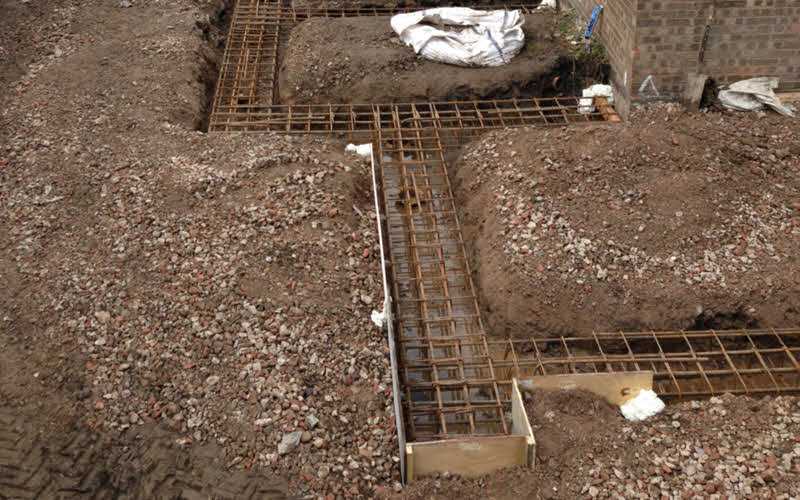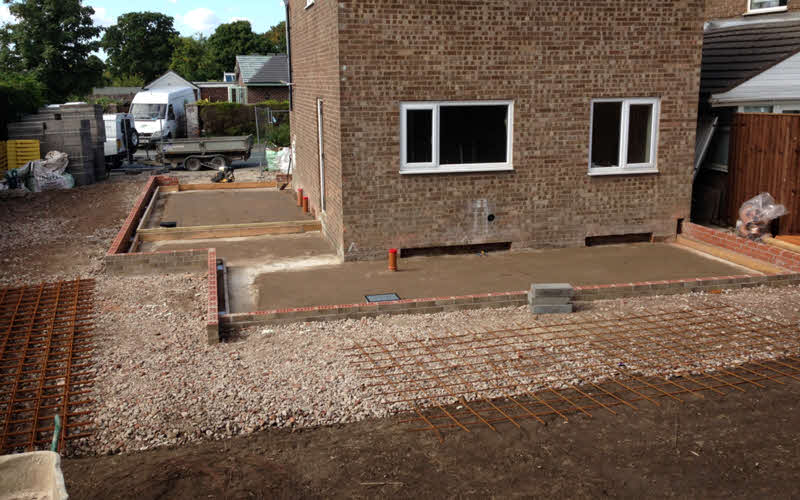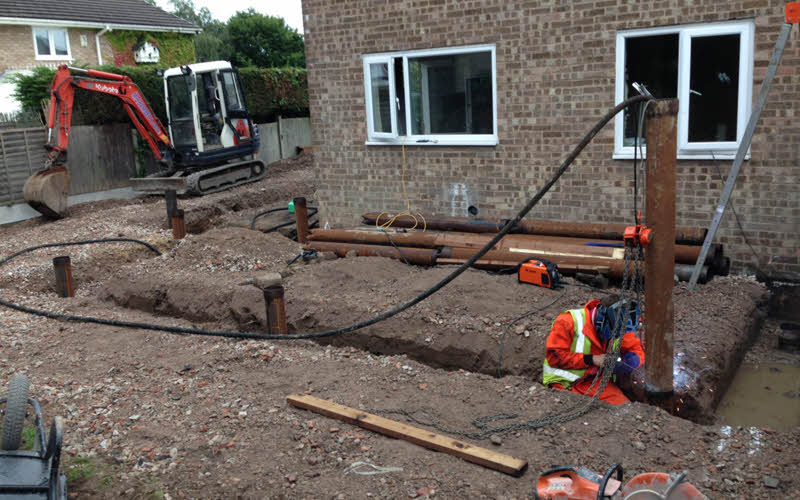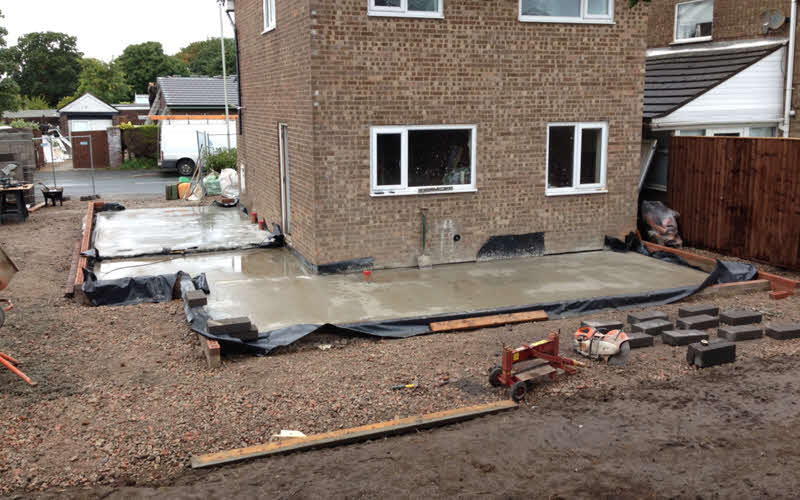Underpinning in simple language creates support below the ground for an already existing structure at its top. It extends the foundations of the structure down to a depth where they can provide the correct support outside the influence of low-bearing capacity soils. The load is transferred to a suitable bearing stratum and it is required when the structure is sinking or showing signs of subsidence.
It provides strength and support to the structure so that it does not collapse and while the construction technique is improvised, the soil below is excavated and replaced with stronger materials like concrete.

We are a group of specialized and authentic contractors who offer a full range of house underpinning systems. By providing effective and economical solutions to people for remedial or new foundation system we are one of the best underpinning companies. Our highly trained engineers provide the most feasible solution to your problems and ensure that it will be appropriate for the circumstances that are present.
We utilize a wide range of techniques and equipment that enable us to construct a suitable foundation for your building project. We are continuously evolving in both technology and manpower to ensure that our service does well by all our clients.
There are many reasons for underpinning to get done, however, the most important one is when the soil beneath the foundation of the structure starts to move away from it which eventually creates a space between the building and the land beneath it. Due to space, the building is likely to subside into this cavity. Often, this can happen due to the weight of the building itself.
Subsidence can occur due to many reasons like,
Some of the other reasons why underpinning is required include, that maybe the original foundation was just not strong enough, or the usage of the structure has changed over time. The properties of soil might have changed and can also affect the underpinning needs. One other reason could be that maybe a construction nearby is causing the soil to excavate to the nearby side causing support problems in the existing foundations.

There are some clear indications which help you evaluate as to when you need underpinning, some of them are,

When it comes to underpinning, there are several methods available to complete the process. Some of the major ones are,
It is one of the most traditional methods of underpinning and it involves digging of the land beneath the existing foundation to reach a stable stratum deep below the existing one. This is a low-cost method and is suitable mostly for shallow foundations.
This is an upgrade to the mass concrete method and involves insertions of a reinforced concrete beam below the existing foundation. Instead of concrete, this method uses steel bars for stronger support. This is also suitable for deeper foundations and is found suitable for most of the ground conditions.
It starts with digging a hole in the ground through the existing wall of the foundation so that a horizontal beam of concrete mass can be accommodated so as to distribute the load. Piles are then used at either end of the hole or the foundation to support the structure. This method is used when a person wants to shift the current load of the foundation to another stable reinforced platform.
It is used when the foundation needs to be extended only on one side and the structure already has a stronger interior column. It is faster than the traditional methods and has a high load-carrying capacity.

Underpinning is a major advantage for the structures that are being built or have been built earlier as it provides a boost to the stability and strength of the foundation. Some of the advantages of getting it done are,
The most basic reason is that it improvises the foundation of the structure which might have been destroyed due to many reasons. It ensures that the foundation is prevented from all sorts of calamities.
A property with finished underpinning will have more value in the market and it makes it look more desirable to the buyers. So it is financially wise to get your house underpinned if you wish to sell it anytime in the future.
Falling homes can cause vertical height space issues in the building and underpinnings to prevent that. It allows you to have better light fixtures.
There is no fixed time for the process to come to completion. It all depends on the number of underpins which have been specified by the engineers at work.
It has been observed that approximately two weeks are required to put ten underpins. So, according to this calculation, approximately a month is required for the underpinning of a complete house.

This cannot be told unless the complete information about the soil structure is known. Not all types of underpinnings are suitable for all kinds of foundations. It also depends upon the underpinning services used.
We take all types of projects and provide ideal solutions which are suitable for all types of buildings from large to small scale. We ensure that the solutions are cost-effective that suit your specific requirements.
Our highly trained staff is given vocational health and safety training to ensure that any damages to your building are prevented. They also ensure that the contractors and the customers are on the same page regarding any decisions for the property.
We strive to maintain our reputation in the industry and at the same time for customer satisfaction and hope to get good recommendations from them. With a wide range of modern equipment, we are completing all the projects with sincerity and dedication and leading the underpinning industry.
Importance of Underpinning in Construction and Building Safety
Underpinning is a vital process in construction and renovation, providing additional support to foundations that may have become weak or need strengthening. Whether it's due to natural wear, structural changes, or ground movement, underpinning ensures that the stability of a building’s foundation is reinforced, extending the structure's lifespan and safeguarding it against potential risks. Here, we explore the importance of underpinning and why it’s essential for safe, long-lasting structures.
1. Enhances Structural Stability - The primary purpose of underpinning is to increase the depth and load-bearing capacity of the foundation. This is especially crucial for buildings situated on soil that shifts over time or those in areas susceptible to seismic activity. By reinforcing the foundation, underpinning stabilizes the structure, making it more resistant to damage from ground movements or shifting soil.
2. Prevents Further Damage - Foundations can deteriorate due to several factors, including moisture, soil subsidence, or poor initial construction. Left unaddressed, these issues can cause cracks in walls, uneven floors, and even significant structural failure. Underpinning addresses these root issues, reinforcing the foundation to prevent further damage and reduce the need for costly repairs in the future.
3. Enables Safe Modifications and Expansions -Underpinning is often required when property owners wish to add extra floors or expand the structure. Since the existing foundation may not be able to support the increased load, underpinning strengthens it, allowing safe modifications without compromising stability. This is a common requirement in cities where space is limited, and upward or outward expansion is necessary.
4. Increases Property Value - A well-underpinned foundation not only strengthens the building but also enhances its market value. Prospective buyers are more confident investing in properties with robust foundations, knowing they’re safe from foundation-related issues. Underpinning, therefore, adds long-term value by securing the structure's integrity, making it an appealing selling point.
5. Ensures Compliance with Building Regulations - In many regions, regulations mandate that foundations meet specific standards, particularly if the building is in an area prone to soil instability or natural disasters. Underpinning ensures the property meets these codes, making it compliant with local regulations. This compliance is essential for insurance coverage and may be necessary to obtain permits for future renovations.
6. Improves Safety for Occupants -Weak foundations pose a safety risk to those within the structure. A stable foundation minimizes the risk of structural collapse, ensuring a safe environment for occupants. Underpinning mitigates these risks, offering peace of mind to property owners and residents alike by protecting the building against potential hazards.
7. Supports Historic Preservation - Many older buildings were constructed with foundations that have deteriorated over time. Underpinning allows for the preservation of these historical structures by reinforcing their foundations. This process ensures that these buildings can stand the test of time while retaining their historical and cultural significance.
Conclusion
Underpinning is a critical investment in the safety, longevity, and value of a building. It reinforces the foundation, adapts it to modern needs, and ensures compliance with safety standards. Whether for repairs, expansion, or preservation, underpinning plays a foundational role in protecting the integrity of structures and the safety of their occupants.